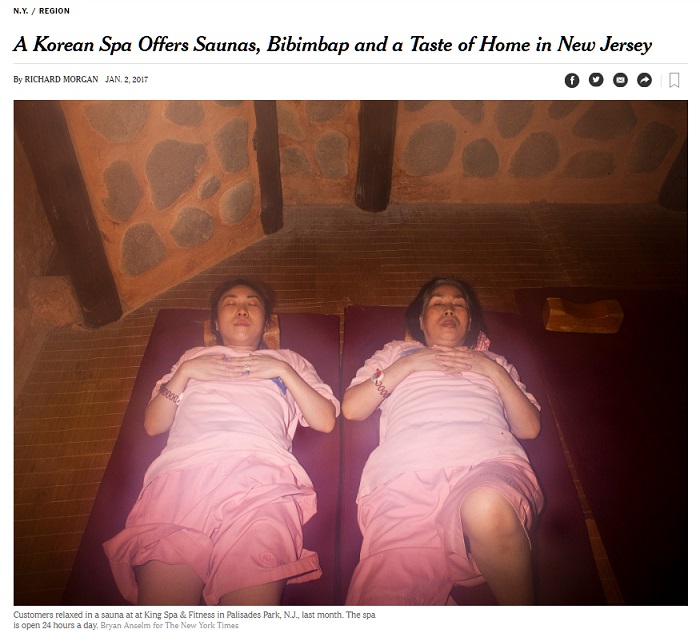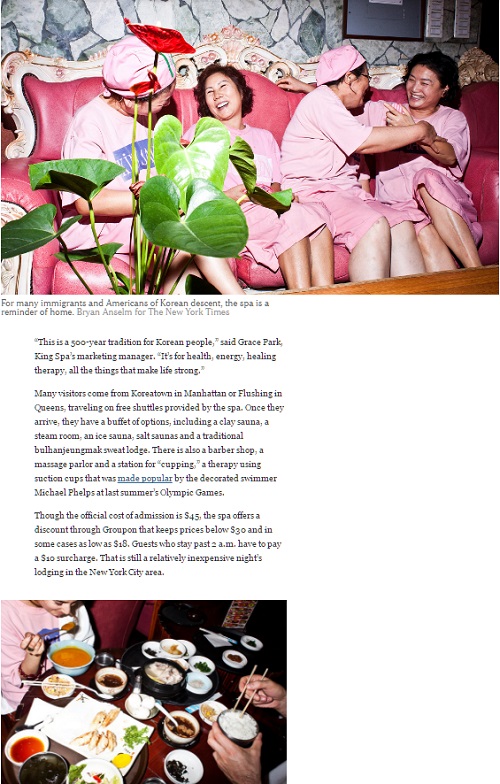
The New York Times sheds new light on the habits and traditions of Korean public baths and spas, traditions that date back centuries, in a Jan. 2 article titled 'A Korean Spa Offers Saunas, Bibimbap and a Taste of Home in New Jersey.' The article takes readers to King Spa & Fitness, a thriving jimjilbang in Palisades Park, New Jersey.
“It’s something different. Who doesn’t want something different for once?” said Angel Melendez, 24, a track coach, to The New York Times (NYT) as he basked in a Korea-style hot sauna, known as a jimjilbang (찜질방), in New Jersey. He had driven with two friends four hours from Boston to New Jersey to find himself sweating in one of the blistering hot steam rooms at the spa, a tradition that many Koreans have long enjoyed.
The NYT recently focused on the habits and traditions of Korean jimjilbang public baths and spas, traditions that have been around for eons in Korea and which are now booming across the U.S. Under the title “A Korean Spa Offers Saunas, Bibimbap and a Taste of Home in New Jersey,” writer Richard Morgan visited King Spa & Fitness, the King Spa for short, a thriving Korea-style jimjilbang spa in Palisades Park, New Jersey. He spoke with some of the spa-goers, too, describing it as, “a 40,000-square-foot oasis of serenity and relaxation.” The spa has been welcoming an increasing number of non-Korean customers these days, like Melendez, who are willing to make a four-hour drive just to experience the steam rooms, bathing amenities and other facilities, the article said.
“In a banya (a Russian sauna), you wait to sweat. Here you sweat immediately,” said Ilan Reznikov, 25, from Brooklyn, who came here after a year of urging from his Korean fiancée.
This place offers a buffet of sauna options. There's a clay sauna, a steam room, an ice sauna, salt saunas and a traditional bulhanjeungmak (불한증막) sweat lodge. There’s also a barber shop, a massage parlor and a restaurant that serves Korean dishes, like bibimbap mixed rice (비빔밥), bulgogi Korean barbecue (불고기) and patbingsu (팥빙수), a heap of canned fruit, syrup, condensed milk and sweet red beans atop shaved ice.
The article quoted Grace Park, King Spa’s marketing manager, who said, “This is a 500-year tradition for Korean people. It’s for health, energy, healing therapy; all the things that make life strong.”
“For immigrants and Americans of Korean descent,” the article continued, “the spa’s free shuttles offer a kind of escape from the tourism and gaudiness of Koreatown’s barbecue joints, noraebang and soju spots.” Andrew Lee, 24, from New Jersey, said, “I just forgot this side of my culture. It felt like home.”

The New York Times reports on Jan. 2 that Korea-style spas, ‘jimjilbangs, allow visitors to not only relish a hot sauna, but also to enjoy some Korean food.
The article mentioned that there are 1,800 such Korean jimjilbang public baths and spas across Korea, a fact backed by a Korean government-run website that describes such spas as “a mini vacation spot in the city.”
“Jimjilbangs have been transplanted to the U.S. as the Korean-American population has grown in recent decades,” the newspaper reported, considering that a factor in the rise in the number of such spas found across the U.S. King Spa, too, has franchises in Chicago and Dallas.
“Jimjilbangs are everywhere there -- in train stations, malls, hotels. It’s like their Starbucks,” said Justin Kukuda about the prevalence of public baths and spas across Korea. Kukuda, 29, is a flight attendant based in Newark who became familiar with such saunas when he was stationed with the U.S. Air Force in Korea. He added, “I don’t just come here. I ‘travel’ here.”
By Sohn JiAe
Korea.net Staff Writer
Photos: NYT
jiae5853@korea.kr